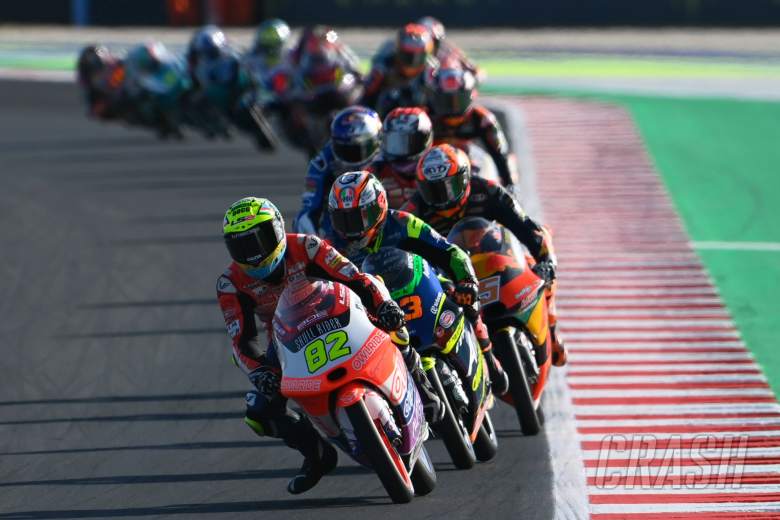Raising age good for safety, but power-grip means Moto3 machines 'too easy'


Raising the grand prix age limit widely supported by MotoGP riders but 'there are some guys well over 18 acting like fools, it’s not just the young guys… [and] the Moto3 bikes need to be harder to ride'
The raising of the grand prix minimum age, the headline decision in a trio of new safety initiatives, was widely backed by MotoGP riders as an appropriate response to this year's teenage tragedies.
Three young Moto3/SSP300 riders - Hugo Millan (14), Jason Dupasquier (19) and Dean Berta Vinales (15) – have been fatally injured during what has always been motorcycle racing's nightmare scenario, a rider falling and being hit by other competitors.
While impossible to eradicate, the succession of deaths went well beyond a freak occurrence, prompting Dorna and the FIM to react. The initial measures, announced sooner than many expected, cover three main areas; age limits/grid sizes, rider equipment and rider communication.
By 2023, age limits will be raised for all classes ranging from Talent Cups to Grand Prix, meaning no rider under 14 will be racing 'at any Grand Prix-type circuits'.
For the Moto3 and Moto2 World Championships the minimum age will be raised from 16 to 18 (matching the existing limit for the MotoGP class) with the exception of the winner of the CEV Junior World Championship and/or Red Bull Rookies Cup, who can enter Moto3 at 17.
While there will be no changes to Grand Prix grid sizes, new caps will be placed on the Talent Cups (30), CEV (32) and World SSP300 (32) classes.
"I’d like to congratulate Dorna for the new rules. I was one hour on the telephone with Carlos Ezpeleta [Dorna's chief sporting officer] to give my point of view and try to help," said Aprilia's Aleix Espargaro, who also explained why he has been so actively involved:
"I’ve been very sad with the losses this year. It was very difficult for me to manage. I thought twice about whether to continue racing when a thing like this happens. If I can improve something by 0.001%, I’ll be there.
"I said to Carlos, 'I’m here to help you'. They are clever enough and have a lot of people around them to improve the rules. But they are not MotoGP riders. It's good to mix both worlds and ideas.
"I am very happy with these new rules," Espargaro confirmed. "I know it’s not easy. From the 'hooligan' fan - which I am of MotoGP - it’s not nice because we like to see talented kids arriving early like Acosta is doing, or reaching MotoGP at 19-years-old as I did in America all those years ago.
"But we have to use common sense. We have to adapt to the new times. I think it’s great. We have to Congratulate Dorna for the change of the rules. They’ve been smart and changed quite a lot.
"On the safety side of the leather suit and helmets. I’m very happy. I think MotoGP has to be a mirror of the small classes. I know there are also many ideas to try something on the bikes to stop the bikes ahead of the crashes."
That 'something' is in the form of an 'automatic, near-instant warning systems for all following riders/motorcycles. The first tests will start as soon as the beginning of the 2022 season, and the system must and will be applicable to Championships of all levels, including Talent Cups.'
"They’re working on nice things to help the rider," Espargaro said. "For example, this year we improve the safety in terms of the yellow flags. We have the [flag] screens which for the riders are really easy to spot where the crash is.
"They are also working on new things with new technology to show there is an accident in front of us. It’s still far. We’re still working on it, so let’s wait a little bit."
Returning to the age issue, Espargaro strongly believes youngsters should spend more time racing minimoto-style bikes at karting tracks, before being exposed to the high-speeds reached at full-size circuits.
"The most important thing is to educate kids to arrive in big tracks like Barcelona, Mugello a little later," Espargaro said.
"All over Europe we have very nice karting tracks where kids can learn and improve their skills. If they crash in the middle of the track, and another mini bike hits them, the bike weight is half.
"We don’t need to allow kids of 10-12 years old to go on a big track at 200kph. They have to wait, improve skills on karting."
On the shift away from minimoto and towards bigger bikes, Espargaro added: "I think in Italy minimotos disappeared a bit later than in Spain.
"In Spain, Pablo and Fonsi Nieto raced a lot with minimotos. When I arrived at 10 years old it was not these types of bikes. We started having 50cc bikes with bigger wheels. The bigger wheel bikes were closer to Moto3 or 125.
"I remember I Jumped on a 125cc at 12 years old in Barcelona, which was crazy.
"I hope minimotos come back again. In Spain we have very nice karting tracks. These minimotos with small wheels will allow riders to improve their skills.
"Aprilia is working on this with the young kids. I have the Aprilia 250, the bike they did with [mini-bike specialist] Ovale. A very nice bike to train [with on small tracks]. It's unbelievable how physical the bike is, how you need to force the bike to make the corners. You can learn a lot.
"So why do we need to go to Barcelona and ride at more than 200kph with Moto4 or Moto3 bikes? For me it’s a bad idea. I hope these minibikes and schools come back again and the safety for sure will improve."
Jack Miller, another MotoGP rider that has urged for action to be taken, also supports the age change. But the Australian warned it's far from a complete fix and remains concerned by the low power-to-grip ratio of the 'easy' Moto3 machinery.
"I think something has to be done. It looks like it is being done," said the factory Ducati rider and triple MotoGP race winner, who hadn't ridden a road bike until he was 14.
"For sure, [raising the age limit] gives these boys some time to mature and understand [but] there are some guys well over 18 acting like fools. Don’t get me wrong, it’s not just the young guys.
"[And] something has to be done with the bikes and the tyres. The bikes need to be harder. Give them more horsepower or give them less tyre. There is too much tyre for how much horsepower they've got and it makes it too easy to ride.
"You see highsides at end of races when the tyres are knackered and they don’t have an idea of what’s going on. But when it comes to a qualifying lap you don’t see highsides because the tyres are good enough and the bike doesn’t have enough power to spin it.
"Anyone can jump on. It takes skill, but you don’t need that technical finesse to be here. Especially when a massive train starts at Mugello or somewhere like that, If there is a guy losing a tenth or two in the back section or even more, they can grab a slipstream – because it’s so prominent – and stay in the group and cause chaos.
"Whereas the natural progression would be for them to drop back in the past. Be it in 125s or the beginning of Moto3.
"It’s fantastic from a rider and a team’s point of view. You can be on the same material as the factory bikes. In the 125s in the past there were three or four teams that could win. You had to slowly progress and build your way up.
"That was the way it was for me. The same for Marc [Marquez] and for many of them. You had to find your way in. You were not just gifted a Factory bike in the first year. That’s where the age came into it as well. That can help."
Because technical rules have to be decided by agreement between the manufacturers, any changes will take longer to agree than the Dorna/FIM measures.



